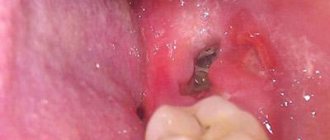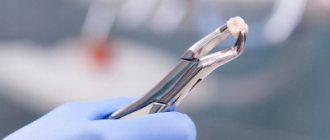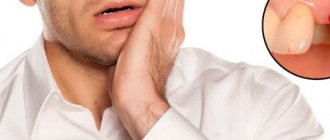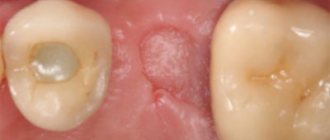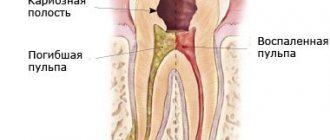Usually, the healing of the hole after tooth extraction occurs painlessly and does not cause any sensations in the patient. It would be good if everyone knew how this process works and how to speed it up.
Proper oral care after tooth extraction and following all the dentist’s recommendations will help speed up the healing of the hole and avoid complications.
Stages of socket healing by day
- The bleeding that occurs after tooth extraction stops after a few minutes , and a blood clot is formed that protects the wound from the penetration of microbes. Under the clot, damaged tissue is being restored, so it is so important to maintain its integrity until the hole heals completely.
- Day 1 – the processes of epithelization (healing) of the wound surface begin.
- Day 3 - signs of epithelization become noticeable, healing begins from the edges of the wound and moves towards the center.
- Day 4 - granulation tissue begins to form - a type of connective tissue that is formed in the body only during wound healing by secondary intention, when there is a strong defect in the skin.
- Day 7 - granulation tissue replaces part of the blood clot, it remains only in the center of the hole. Osteoid (bone) beams begin to appear, indicating bone formation. At the same time, epithelial tissue grows significantly from the edges of the gums.
- 14th -18th day - epithelization of the wound is completely completed, its surface is tightened and heals completely. By this time, the hole is completely filled with granulation tissue, and osteoid tissue is actively developing.
- After a month, a significant part of the hole is filled with new bone tissue. By the end of the second, sometimes third month, this process is completely completed.
- 4th month - bone beams in the newly formed osteoid tissue calcify, it matures: it becomes spongy and does not differ from the rest of the bone. At the same time, the edges of the socket dissolve, the alveolar edge in the area of the extracted tooth becomes thinner and lower than it was before surgery.
What to look for
The most serious consequences that can occur after wisdom tooth removal:
- Alveolitis. This is an acute inflammatory process. It begins in the tooth socket and gradually spreads to other gum tissues. The most common reason for the development of alveolitis is improper care after removal.
- Paresthesia. Develops when the root of the jaw nerve is damaged or irritated. Manifested by a feeling of tingling, burning, numbness.
To avoid developing serious problems, monitor your oral health. The first symptoms are not difficult to replace:
- Bleeding from the socket. This is not always a sign of complications. Immediately after removal this is a normal reaction of the body. In the first minutes after tooth extraction, bleeding will be slightly heavier. The dentist treats the wound with antiseptics and packs it. After some time, the bleeding stops. Slight bleeding persists for 2-3 hours. This is also normal. You should pay attention to bleeding if it is profuse and begins several hours after removal. In this case, contact a specialist immediately.
- Swelling and pain. This is also a natural reaction. Pain occurs as the anesthetic wears off. Normally it lasts 2-3 days. At the same time, the gums swell slightly. You should sound the alarm if the swelling transfers to the cheek. In complex cases, the tumor can be very large. Severe swelling is one of the symptoms of alveolitis.
- Fever. On the first day after removal, the temperature rises to 37 degrees. Such an increase is within normal limits, especially if the operation was complicated. When the temperature lasts more than a day or rises strongly, this is a symptom of inflammation. To prevent the inflammatory process from spreading to neighboring tissues, visit a dental clinic.
- Suppuration. The inflammatory process, accompanied by suppuration, has pronounced symptoms. Suppuration is indicated by a putrid odor from the mouth and an unpleasant taste. When examining the tooth socket, you may notice gray plaque or white purulent contents. In this case, you need to go to the dentist immediately.
- Headache. Immediately after wisdom tooth removal, headache is normal. It is caused by stress and anesthetic drugs. If the headache is severe and is accompanied by fever, swollen lymph nodes, and weakness, we recommend visiting a doctor.
Healing of the socket with gum inflammation
If tooth extraction was carried out against the background of inflammation, or the inflammatory process in the gums developed later, epithelization of the wound begins on the 10th -14th day, bone beams appear only by the 15th day. A significant part of the socket is filled with young osteoid tissue only by the end of the second month.
After a complex tooth extraction, when the gums rupture and the walls of the socket are traumatized, the edges of the gums cannot come together for a long time and the epithelization process slows down. Wound healing can only be completed after 1-1.5 months. In this case, the development of new bone tissue is delayed.
What to drink after tooth extraction: taking medications
The doctor decides what medications to take after tooth extraction. The list of recommended medications includes:
- antihistamines – reduce swelling and improve overall well-being;
- painkillers - analgesics are taken if necessary every 4-6 hours after the end of anesthesia;
- antibiotics - you can take them only as prescribed by a doctor after a complex removal, if inflammation of the socket develops, or if there are concomitant diagnoses.
Aspirin is strictly prohibited, as it thins the blood and can increase bleeding.
How to speed up the healing of a hole
To speed up the healing of the hole after tooth extraction, you need to follow these rules:
- Do not touch the blood clot on the socket with your tongue, much less with your hands or a toothpick, so as not to damage it. The presence of a clot is a guarantee of speedy healing of the wound.
- For three hours after visiting the dentist, you should not eat or rinse your mouth. Compliance with this point will also help maintain the integrity of the blood clot.
- · Drinks and food should not be too hot or cold for several days after removal. The food chosen is soft, without coarse inclusions, to prevent injury to the gums.
- You should not engage in heavy physical work for several days to avoid opening the wound and resuming bleeding.
- Since tobacco smoke and alcohol irritate the mucous membrane and inhibit the healing of the hole, you need to stop smoking and drinking alcohol for a while.
- To prevent infection from entering the wound and reduce inflammation after a traumatic tooth extraction, antiseptic baths are used. For them, solutions of chlorhexidine or furatsilin, infusions of sage, chamomile, and eucalyptus are used. The solutions are taken into the mouth, held for several minutes and carefully spat out.
- On the third day after removal, you can carry out antiseptic rinses with the same agents.
- Taking anti-inflammatory drugs (nimesulide, ibuprofen) will help not only eliminate pain, but also relieve the inflammatory process, which also helps accelerate socket regeneration.
- If the doctor has prescribed antibiotics, you should not refuse them, since eliminating the microbial infection shortens the healing time.
- When brushing your teeth, be careful not to touch the wound with the brush.
- To speed up healing, you can use Solcoseryl dental paste. It enhances intracellular energy exchange, due to which cell regeneration and restoration of damaged tissues are accelerated. Solcoseryl also creates conditions for the growth of granulation tissue. The paste is applied to a previously dried surface, then moistened with water. Before using the medicine, it would be more correct to ask your dentist about when to start using Solcoseryl after tooth extraction and how many times a day to apply it to the gums.
Occurrence of complications
- difficult access;
- frequent retention;
- unpredictable structure;
- features of the location of the mandibular alveolar nerve.
Are common
Painful sensations
Swelling of the tissues of the face and neck
- swelling of the lymph nodes;
- discomfort when swallowing;
- painful sensations during mouth movements, radiating to the ear.
Hematomas
Alveolitis
complications after wisdom teeth removal
- the gums swell and turn red;
- local pain and headache are observed;
- sore throat;
- the temperature rises, muscle aches appear;
- lymph nodes become inflamed, most often the submandibular ones.
- increased persistent temperature;
- poor general health;
- severe migraine-like pain;
- nausea;
- other signs of intoxication of the body.
Increased body temperature
A slight increase in body temperature to 37.5-38 °C also often occurs in the postoperative period. This complication occurs due to a reaction to inflammation. The temperature should completely return to normal within the first day, and if it continues to rise and rise, it means that more serious pathologies have arisen and you need to go to the hospital again.
Bleeding
- rupture of large vessels;
- capillary fragility;
- hypertension.
Damage to the roots of adjacent teeth
Flux
- redness, suppuration and swelling of the gums;
- severe shooting pain;
- temperature increase;
- weakness.
Others
- displacement of the seventh tooth (2 molars);
- mouth rupture; cut gums or cheeks;
- jaw injuries.
What to do when the hole has healed?
After the hole has healed and filled with full bone tissue, it is necessary to take care of restoring the dentition. The absence of even one tooth can lead to displacement of the remaining teeth, changes in bite, diction, aesthetic problems, and resorption (atrophy) of bone tissue at the site of the extracted tooth. A tooth can be restored using implantation, when an artificial root is implanted into the bone and a crown is installed on it. This method of prosthetics is by far the most comfortable and effective for the patient.
If bone tissue atrophy has already occurred, bone tissue augmentation is performed before installing the implant. The procedure allows you to perform high-quality prosthetics and restore the functionality and aesthetics of your teeth.
Wisdom tooth removal
Wisdom teeth are considered full-fledged elements of the oral cavity. They are involved in chewing food (if they are located above each other and have contact), and can act as a support for bridges and removable dentures in the future. There are specific indications for extraction in their case. For this reason, the decision about whether wisdom teeth need to be removed is made only by the attending physician.
The most common problem with eighth teeth is their growth. Only some teeth form and grow completely without complications, but often these processes are accompanied by a number of difficulties:
- semi-retinated or impacted elements that have formed in the bone tissue, but have not erupted or only partially erupted. Their position can be vertical, horizontal, or with their roots outward. Because of this, neighboring elements suffer, constant pain appears;
- violation of position (dystopia). Since wisdom teeth erupt without predecessors (baby teeth), and the jaw bone is already formed and does not develop, the position of the elements is often incorrect. They injure the mucous membrane, overlap other crowns, and put pressure on neighbors. This leads to inflammation. The doctor will determine whether the position can be restored with orthodontic treatment or whether it is better to remove the wisdom tooth;
- appearance of a gingival hood. When slowly cutting through the mucosa, an area is formed in which bacteria and food debris accumulate, which are difficult to clean. This leads to acute inflammation, which can provoke the appearance of pus;
- destruction, caries. Elements may appear immediately underdeveloped with carious lesions.
The doctor determines whether wisdom teeth should be removed or not based on complaints and the clinical picture. Problems with even one or two teeth interfere with the normal functioning of the entire dental system. Pain appears when opening the mouth and chewing. The bite and position of the incisors may even change.
How a wisdom tooth is removed depends, as in the case of permanent elements, on the condition of the dental system. In the absence of contraindications, manipulation is carried out with ordinary forceps.
What therapy is possible for dry socket syndrome?
Before treatment, the doctor must send the patient for an x-ray. It will reveal whether there are tooth fragments left in the hole. Then anesthesia is given, because the pathological process is accompanied by serious pain.
Table. How is dry socket syndrome treated?
| Treatment stage | How it goes | Notes |
| Cleaning the hole | The fragments and leftover food are removed, the wound is washed with an antiseptic. | Hydrogen peroxide or Furacilin can be used |
| Curettage | This is what they call scraping the inner walls of the socket. | The process is unpleasant, but due to anesthesia it does not cause serious pain |
| Inspection and reprocessing | And antiseptics are used again | This may be a solution of potassium permanganate |
| Drying the hole | Occurs using a special tool | Then anesthesin is poured into the hole |
If it is a serous inflammation, the doctor may apply an iodoform dressing to the wound.
Iodoform dressing for the treatment of post-extraction sockets
In case of a purulent inflammatory process, the bandages need to be changed daily until the patient feels better. In most cases, treatment is accompanied by antibiotics.
How is dry socket treated in severe cases of pathology?
If complications arise, the therapy will be slightly different. And complications most often occur when the patient does not immediately contact the dentist.
A severe form of dry socket syndrome is treated as follows.
- Why do my gums hurt after tooth extraction?
- The cavity is treated and a swab moistened with special antibiotics is inserted into it. Usually, drugs that quickly relieve inflammation are added to this remedy.
- Next, an antistatic blockade is carried out.
- To clean the upper part of the wound from dead tissue, proteolytic agents are used.
- This is followed by blocking the nerve with lidocaine.
- Warm rinses are carried out with preparations such as potassium permanganate.
Potassium permanganate solution
To this list are added those procedures that the doctor uses for uncomplicated forms of dry socket syndrome. In general, the healing process will take at least a week. But if a wisdom tooth is pulled out, the recovery period may be delayed. After two, maximum two and a half weeks, the situation should normalize - granulation tissue will begin to form inside the walls of the socket. The pain will decrease, the swelling will subside, and the gums will turn pink. The first epithelial layer will begin to form.
Granulation tissue in the socket
Treatment
Treatment methods will depend on the severity of alveolitis:
- Light - rinsing with antiseptics and anti-inflammatory agents.
- Medium - taking antibacterial agents, filling the hole with medicine.
- Severe - hospitalization, therapy, depending on complications, recovery includes physiotherapy, ultraviolet irradiation.
Important! Antiseptic rinses and antibiotics only temporarily eliminate the symptoms of inflammation, so curettage (cleaning the socket) will be the only effective method of treatment.
Treatment at home
Treatment at home is carried out for mild inflammation
Treatment at home is carried out for mild inflammation.
For this purpose, the drugs Chlorhexidine, Miramistin, and potassium permanganate solution are used.
The mouth is rinsed with the products after each meal.
Additionally, you can use decoctions of chamomile, sage, calendula, and oak bark.
The doctor may prescribe Solcoseryl dental paste. It has an analgesic effect and promotes the healing of damaged tissue.
It is introduced into a hole pre-washed with an antiseptic. The paste gradually dissolves, so there is no need to remove it. Periodically it needs to be added to the hole.
Dental care
Stages of dry socket treatment at the dentist:
- Anesthesia.
- Removing food particles and necrosis from the hole.
- Washing with an antiseptic.
- Drying and filling the hole with iodoform turunda.
Important! Without removing the necrosis, any other therapeutic measures will be useless.
After curettage, the dentist prescribes medications and gives recommendations on how to care for the hole. The medicine in the hole needs to be changed every 3-5 days. You will have to visit the dentist at least 3 times.
Treatment by creating a secondary clot
When the cavity fills with blood, the dentist applies an anti-inflammatory agent and places several stitches
Treatment by creating a secondary clot involves curettage of the socket to provoke bleeding.
When the cavity fills with blood, the dentist applies an anti-inflammatory agent and places several stitches. After the procedure, you need to take antibacterial drugs.
This method of treatment is possible only in 2 cases: when the patient seeks help immediately after a clot has fallen out, and in case of indolent alveolitis without pronounced symptoms, provided that the hole is filled with granulation.
Medication assistance
After cleaning the hole, the following medications are prescribed:
- painkillers based on NSAIDs - Ibuprofen, Nise, Diclofenac;
- antibiotics - Amoxiclav, Lincomycin, Unidox-solutab;
- Chlorhexidine solution 0.05% for rinsing.
Removal of tooth granuloma
If therapeutic treatment of dental granuloma does not help, surgical intervention is used. From the outside, through the bone, access is made to the tooth root, the granuloma is scraped out, the place of its attachment is carefully processed, and the mucous membrane is sutured. In some cases, the infected root tip of the tooth is excised. Subsequently, the bone is restored, and the tooth continues to serve for a long time. Sometimes it is necessary to remove the entire root. This is also a common operation today. In this case, the desired root is excised along with the coronal part, and if the remaining roots are able to withstand the required load, a prosthesis is installed in this place.
If a tooth granuloma has been removed, but pain or inflammation remains, and it is painful to press on the tooth, you should contact a dentist in Moscow again. The situation when a tooth hurts after treatment or removal of a granuloma is common. The pain may persist for a long time, but you should make sure that there is no inflammation and that this pain is truly residual and not an indicator of another problem.
Treatment of dental granuloma: what to do?
Today, therapeutic treatment of dental granuloma is successfully carried out; in some cases, dental granuloma is treated with a laser, which does not require tooth extraction. As a rule, it is necessary to carry out high-quality endodontic treatment of the canals: cleaning, rinsing with an antiseptic and filling. They must be carefully sealed so that infection cannot enter from the oral cavity. Subsequently, the dentist monitors the condition of the tooth and the tissues around it. After five to six months, an x-ray should be taken, and if the tumor decreases in size or disappears, the therapy is considered successful. If it continues to grow, this makes it possible to diagnose not a granuloma under the tooth crown, but a dental cyst and re-treatment, which is carried out by a surgeon.
Cyst and granuloma of the tooth
Previously, it was generally accepted that if a neoplasm on the root of a tooth measures up to five millimeters, it is a granuloma, and if it is more than ten millimeters, then it is a dental cyst. Some dentists also distinguish a certain transitional stage - cystogranuloma, but practice shows that there are granulomas reaching even twelve millimeters, so an accurate diagnosis cannot be made only by the size of the formation and its shape. In addition to X-rays, histological examination of tissues is necessary.
The question often arises of how a granuloma differs from a dental cyst. The fact is that a cyst is a bladder filled with fluid or pus, with a shell formed by connective tissue and lined on the inside with endometrium. Secretory fluid is produced by the membrane, and due to this the cyst increases in size. Granuloma grows due to the growth of tissues containing infected cells.



